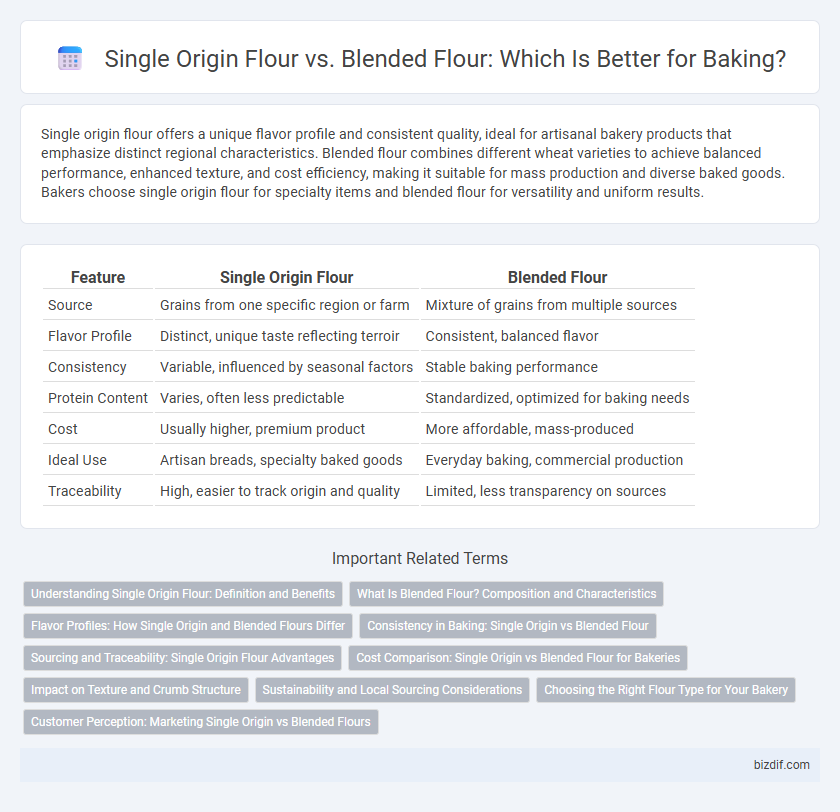Single origin flour offers a unique flavor profile and consistent quality, ideal for artisanal bakery products that emphasize distinct regional characteristics. Blended flour combines different wheat varieties to achieve balanced performance, enhanced texture, and cost efficiency, making it suitable for mass production and diverse baked goods. Bakers choose single origin flour for specialty items and blended flour for versatility and uniform results.
Table of Comparison
| Feature | Single Origin Flour | Blended Flour |
|---|---|---|
| Source | Grains from one specific region or farm | Mixture of grains from multiple sources |
| Flavor Profile | Distinct, unique taste reflecting terroir | Consistent, balanced flavor |
| Consistency | Variable, influenced by seasonal factors | Stable baking performance |
| Protein Content | Varies, often less predictable | Standardized, optimized for baking needs |
| Cost | Usually higher, premium product | More affordable, mass-produced |
| Ideal Use | Artisan breads, specialty baked goods | Everyday baking, commercial production |
| Traceability | High, easier to track origin and quality | Limited, less transparency on sources |
Understanding Single Origin Flour: Definition and Benefits
Single origin flour comes from wheat harvested in a specific geographic location, preserving unique terroir characteristics that influence flavor and texture. This precise sourcing enhances the flour's consistency and purity, making it ideal for artisanal baking and highlighting regional grain qualities. Bakers benefit from single origin flour's distinct aroma and nutrient profile, which contributes to superior dough performance and finished product quality.
What Is Blended Flour? Composition and Characteristics
Blended flour is a mixture of different types of wheat flours or other cereal flours combined to achieve specific baking qualities such as texture, protein content, and gluten strength. Typically composed of hard and soft wheat varieties, blended flour balances elasticity and tenderness, making it ideal for diverse bakery products like bread, cakes, and pastries. Its composition allows bakers to customize flour performance, enhancing dough handling and final product consistency.
Flavor Profiles: How Single Origin and Blended Flours Differ
Single origin flours derive from a specific region, offering unique and consistent flavor profiles that highlight the terroir, such as nutty or earthy undertones. Blended flours combine wheat from multiple sources to create a balanced flavor and texture, often resulting in a milder, more versatile taste suitable for a broad range of baked goods. Bakers choose single origin flour for distinctive, pronounced flavors, while blended flour provides a reliable, adaptable base for diverse recipes.
Consistency in Baking: Single Origin vs Blended Flour
Single origin flour offers consistent flavor profiles and biochemical properties from a specific region, ensuring predictable dough behavior and baking outcomes. Blended flour combines varieties from multiple sources to balance protein content and gluten strength, enhancing overall consistency across different batches. Bakers rely on single origin flour for precise recipe replication, while blended flour provides stability in large-scale production by minimizing variability.
Sourcing and Traceability: Single Origin Flour Advantages
Single origin flour is sourced from a specific region or farm, offering exceptional traceability and consistent quality due to controlled growing conditions. This precise sourcing allows bakeries to highlight unique flavor profiles linked to terroir, enhancing product differentiation and transparency for consumers. Traceability in single origin flour supports ethical and sustainable farming practices, reinforcing brand trust and premium positioning in the bakery market.
Cost Comparison: Single Origin vs Blended Flour for Bakeries
Single origin flour typically costs more due to its exclusive sourcing from a specific region, offering unique flavor profiles and consistent quality that appeal to artisanal bakeries. Blended flour combines grains from multiple sources, resulting in lower production costs and a more affordable price point, making it suitable for high-volume bakeries focused on cost efficiency. Choosing single origin flour can increase ingredient expenses by 20-40%, while blended flour helps maintain budget-friendly operation without sacrificing basic baking performance.
Impact on Texture and Crumb Structure
Single origin flour, sourced from a specific region or farm, provides consistent gluten quality and protein levels, resulting in a more uniform texture and tighter crumb structure in baked goods. Blended flour combines varieties from different origins, offering balanced protein content that enhances dough strength and creates a more open, airy crumb with variable texture. The choice between single origin and blended flour directly affects the bakery product's final mouthfeel, crumb elasticity, and overall quality.
Sustainability and Local Sourcing Considerations
Single origin flour supports sustainability by promoting local sourcing, reducing carbon emissions associated with long-distance transportation, and encouraging the use of regionally adapted wheat varieties that enhance soil health. Blended flour, while offering consistent baking performance, often relies on ingredients from multiple regions, increasing its environmental footprint through expanded logistics and potential monoculture farming. Prioritizing single origin flour aligns with eco-friendly practices and strengthens local economies by fostering traceability and responsible agricultural stewardship.
Choosing the Right Flour Type for Your Bakery
Single origin flour offers consistent flavor profiles and predictable baking results, ideal for bakeries emphasizing artisan quality and traceability. Blended flour combines different wheat varieties to optimize protein content and gluten strength, enhancing dough elasticity and volume for diverse baked goods. Selecting the right flour type depends on your product lineup, desired texture, and baking process precision.
Customer Perception: Marketing Single Origin vs Blended Flours
Customers often perceive single origin flour as a premium product due to its traceability, unique flavor profile, and artisanal appeal, making it a strong marketing point for bakeries aiming to attract health-conscious and gourmet consumers. Blended flour, favored for its consistent quality and versatility, appeals to customers seeking reliable baking results and cost-effective options. Emphasizing single origin flour's distinctiveness and blending flour's functional benefits helps bakeries tailor their marketing strategies to different customer segments.
Single origin flour vs Blended flour Infographic

 bizdif.com
bizdif.com